Whether you have a Comet, Shubunkin, Fantail, or Ryukin, goldfish are probably the most famous pet fish in the world.
But goldfish can live a long time, and grow very large, and their tanks can sometimes get filled with algae.
What’s a good solution to algae blooms in fancy goldfish tanks? Well, algae eaters of course! Algae eaters are fish or invertebrates like shrimp and snails that love to eat algae and help to keep your tank clean.
Here’s a list of 9 of the very best algae eaters to keep with goldfish.
Finding the Right Tank Mates for Goldfish
Before we begin our exciting list of algae-devouring companions, we need to understand a few things about the ingredients that make up the ideal tankmates for goldfish.
Tankmates for Cool Water Temperatures
Firstly, goldfish are coldwater fish. They don’t require a heater and do well at temperatures between 60-73°F.
Although they can tolerate temperatures above this for short periods of time, they won’t be happy being kept in tropical conditions for long.
This rules out most warmth-loving tropical fish as potential tank mates, although a heated tank set at a low temperature of around 72°F could be suitable for goldfish to share with more hardy tropical species.
Tankmates That Are Robust but Peaceful
Secondly, goldfish can get big. Really big! While different varieties have different growth rates, a common single-tailed goldfish can grow an inch every year and can reach a final size of over 15 inches.
Although such gigantic proportions are rare within aquariums, it’s not unusual for domestic goldfish to exceed 8 inches. That’s bigger than most pet fish, meaning your goldfish could become intimidating or even a potential predator for smaller fish and invertebrates.
As long-term tank mates, small fish, and shrimps are out of the question. But if you keep goldfish with larger fish, they also need to be peaceful and not bully your goldfish.
Tankmates That Can Tolerate Poor Water Quality
Lastly, it’s important to understand that goldfish are notoriously messy fish. They produce a high bioload and this is one of the reasons their tanks grow a lot of algae in the first place!
Therefore, fish that need pristine water conditions with high levels of oxygen might struggle to live with a goldfish unless you keep the tank really clean with strong filtration.
See our tips at the end of the article for how to keep a goldfish tank clean with less algal growth!
9 of the Best Algae Eating Tank Mates for Goldfish
Long Fin Bristlenose Pleco
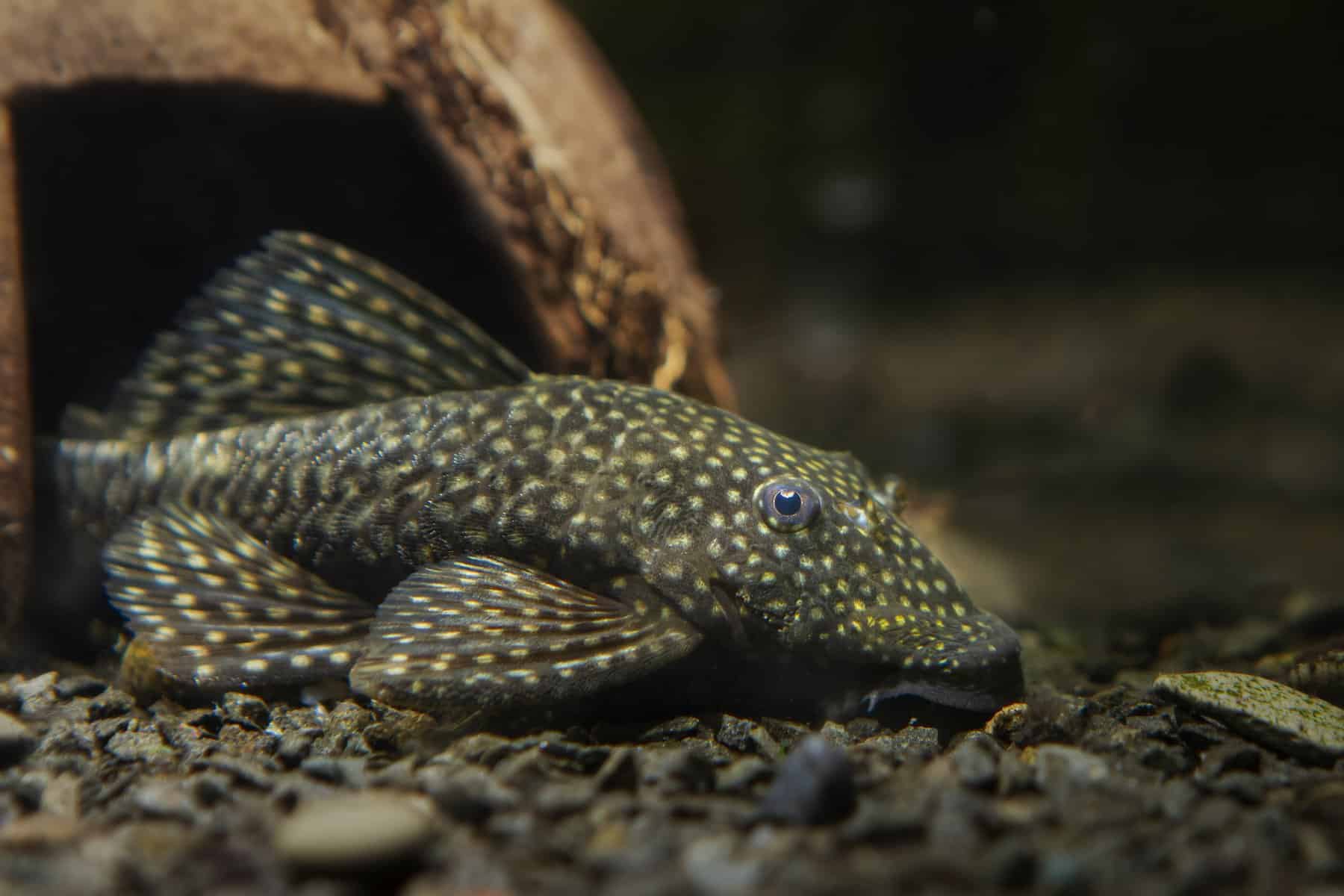
- Scientific Name: Ancistrus sp. ‘longfin’
- Water Temperature: 72 – 86°F
- Maximum Size: 4-5 inches
- Average Lifespan: 10 – 15 years
Plecos or plecostomus are a large family of freshwater catfish that are beloved by aquarists around the world for their ability to eat huge volumes of algae.
Mostly nocturnal, plecos will clean algae from the substrate, rocks, driftwood, and glass.
But since many plecos come from near the equator, they’re unlikely to tolerate the cooler temperatures of a goldfish tank. The long fin bristlenose pleco is an exception to this rule and can tolerate temperatures down to 72°F.
They also have the advantage that they don’t grow too big! Whereas other pleco species such as common plecos can grow to over a foot long, long fin bristlenoses only grow to a meager 4-5 inches.
Perfect size-wise, but make sure they also have a plentiful oxygen supply to remain healthy.
Rubber Lipped Pleco
- Scientific Name: Chaetostoma milesi
- Water Temperature: 71- 80°F
- Maximum Size: 5-7 inches
- Average Lifespan: 9-12 years
Like their cousins, the bristlenose plecos, ‘rubber lips’ are tolerant of cooler temperatures than most of the pleco clan and can be successfully kept alongside goldfish.
Although they grow a little bigger than bristlenoses, their maximum size of 7 inches means they can make a good fit with goldfish in larger tank sizes.
The only potential incompatibility issue of keeping plecos with goldfish is that plecos come from fast-flowing rivers and need a rich oxygen supply and some water current to keep them happy.
Goldfish, especially those with long, fancy fins, don’t tend to like strong currents, but if you turn the filter nozzle towards the bottom of the tank where the plecos hang out, both should be happy.
Amano Shrimp
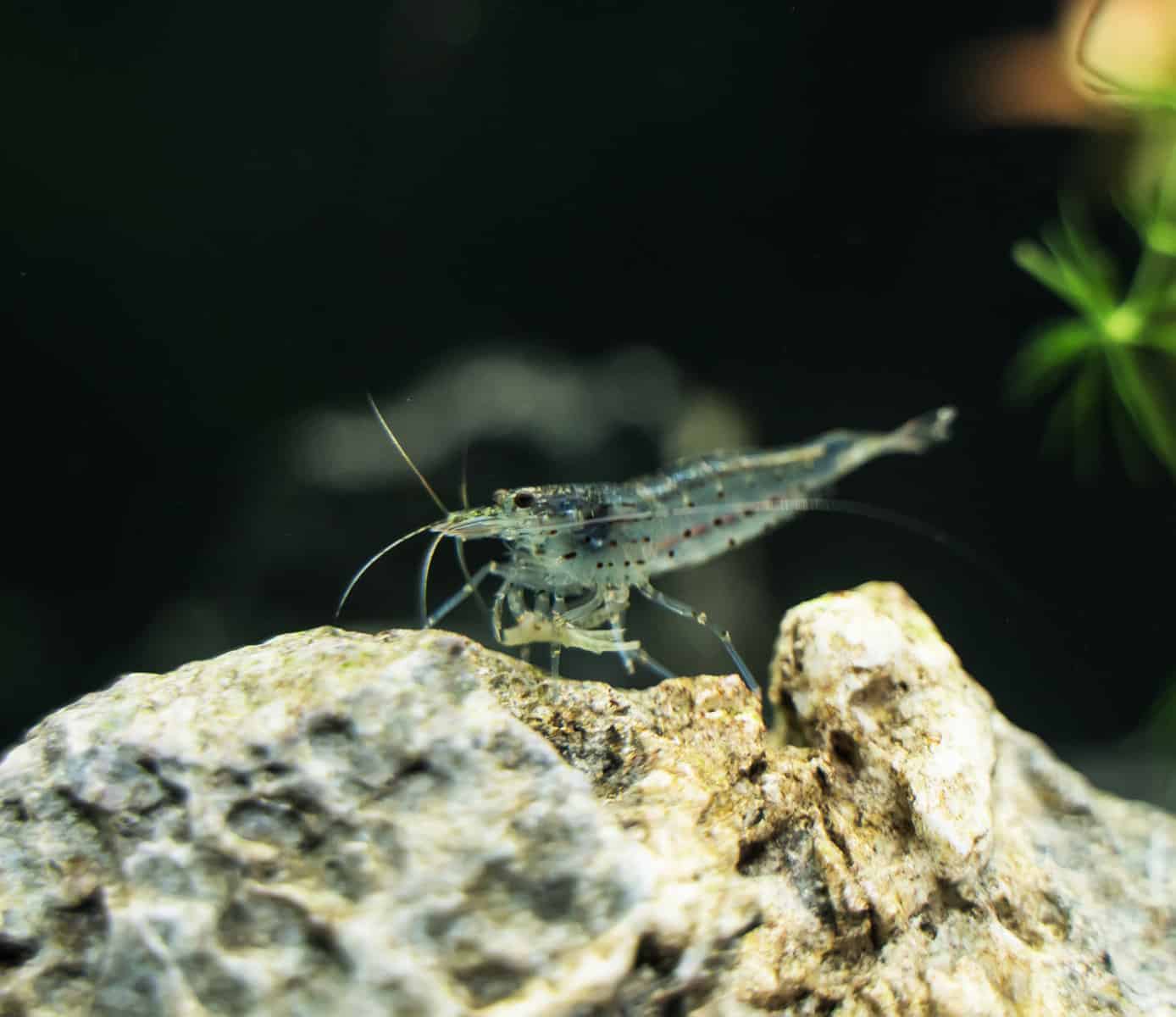
- Scientific Name: Caridina multidentata
- Water Temperature: 64 – 80°F
- Maximum Size: 2 inches
- Average Lifespan: 2-3 years
If you’re looking for an ideal algae-eating companion for young goldfish, then look no further than the Amano shrimp.
Amanos are the kings of the shrimp world when it comes to eating algae, and are famous for chowing down on all kinds of algae including hair algae, brush algae, and most types of string algae that other species may refuse.
We say it is suitable for young goldfish because, well, Amano shrimps only grow to 2 inches long and could easily get gulped down by a mature goldfish!
But since Amano shrimp only live to 2-3 years old, they can happily be placed in the tank with a baby goldfish who won’t grow large enough to eat them before they die of natural causes.
Hognose Cory
- Scientific Name: Corydoras multiradiatus
- Water Temperature: 70 – 75°F
- Maximum Size: 4 inches
- Average Lifespan: 4 years
Cory catfish are some of the most popular aquarium cleaners around, and although they’re not normally classed as an ‘algae eater’ they do help to control algae growth.
By nibbling on bits of loose algae and dead plant matter, and thereby reducing detritus in a goldfish aquarium, they can reduce algae populations considerably, especially when kept in groups, which, as schooling fish, they prefer.
But while most cory catfish are too small to be kept with a full-sized goldfish, hognose cories are an exception. Growing up to 4 inches long, they should be able to stand up to even the meanest goldfish!
They are quite shy, however, and will appreciate refuge, so be sure to add some large rocky caves to your tank for them to hide in.
Nerite Snails
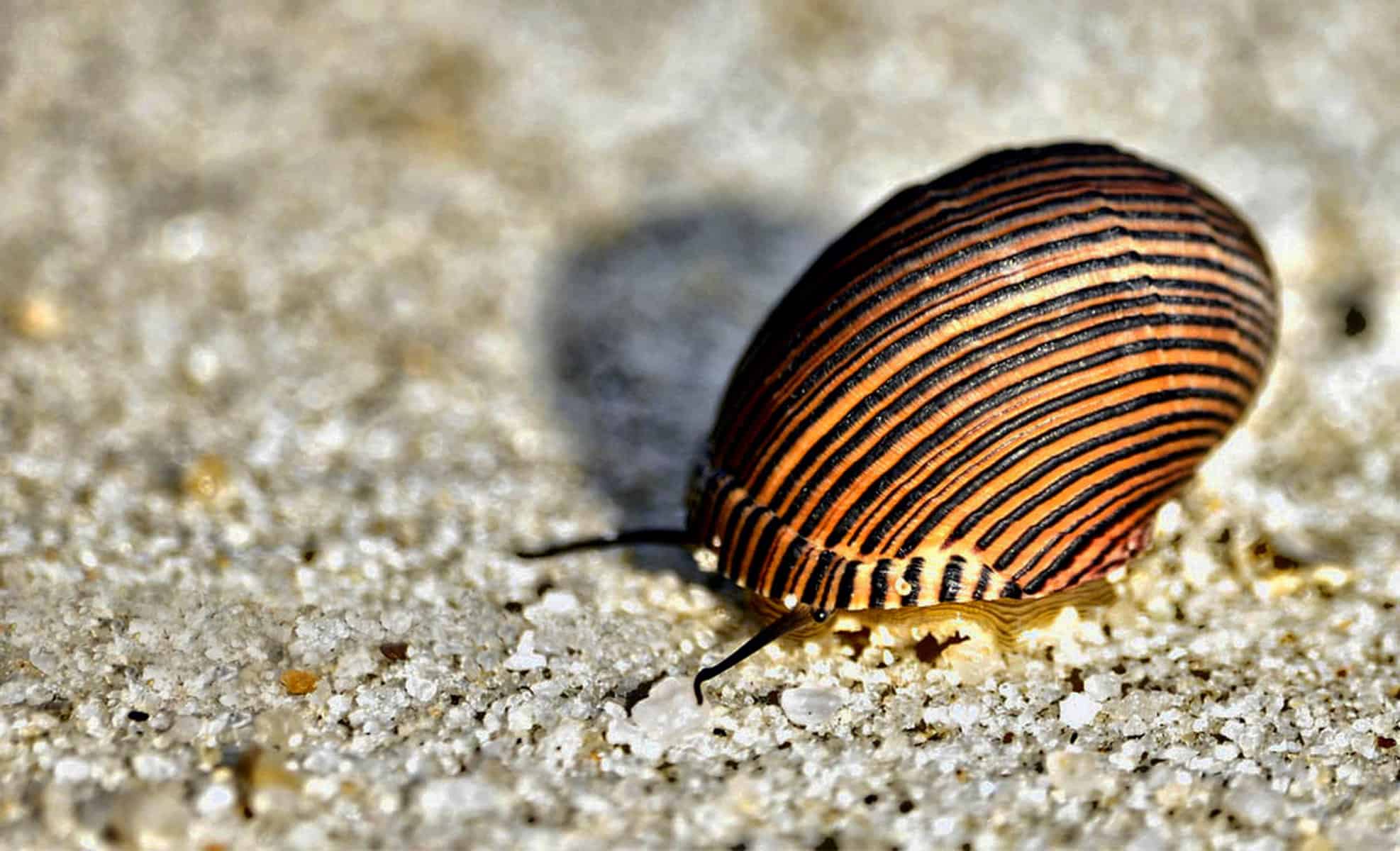
- Scientific Name: Vittina natalensis
- Water Temperature: 72–78°F
- Maximum Size: 1 inch
- Average Lifespan: 1-2 years
While you may have heard that goldfish eat aquatic snails, larger species are unlikely to fall prey to them. At an inch in diameter, and with a tough shell, nerite snails should be able to hold their own against all but the biggest goldfish!
Nerites are also famous for being one of the very best algae-eating snails and will spend their days hoovering up massive quantities of soft film algae, soft green algae, soft brown algae, and brown diatoms.
Green-spot algae seem to be one of the few types of algae that they won’t eat.
As well as being incredibly beautiful, nerite snails have the added advantage of not being able to breed in freshwater, meaning this snail will never crowd out your tank.
On the flip side, nerites only live for a couple of years at most, so you will have to replace them often!
Mystery Snails
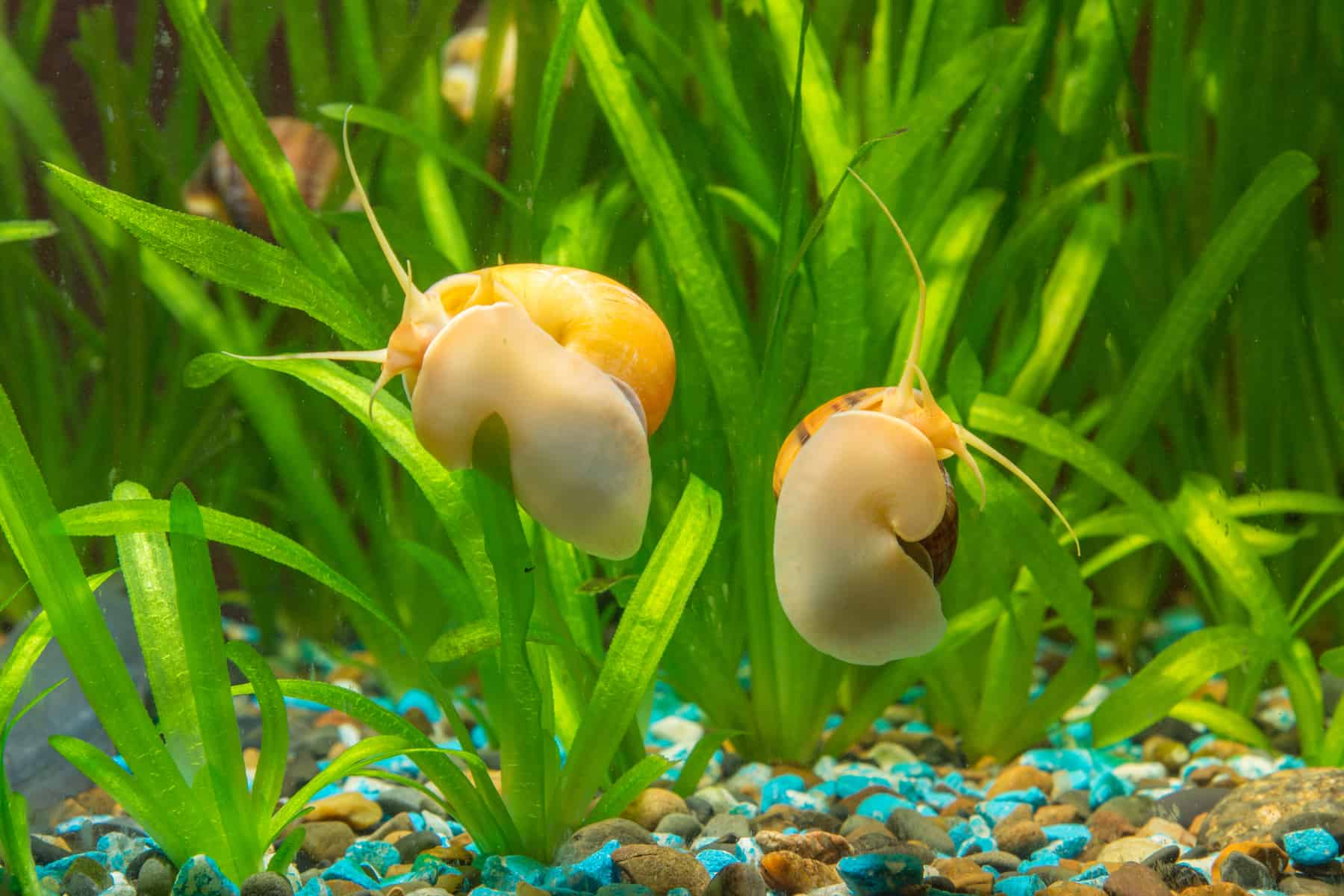
- Scientific Name: Pomacea bridgesii
- Water Temperature: 68–82°F
- Maximum Size: Up to 2 inches
- Average Lifespan: 1-2 years
If you don’t think that nerite snails will be large enough to fend off your hungry goldfish, maybe you should consider mystery snails.
As part of the apple snail clan, mystery snails are among the largest of commonly kept aquarium snails, and their 2-inch shell should be more than enough to see off your goldfish.
Mystery snails are so-called because of their bizarre way of disappearing and reappearing in the tank – so, if you’re worried your goldfish might have eaten yours, don’t give up! It may well re-appear in a few days.
But another reason for their name is that mystery snails can reproduce at an unbelievable rate. Thankfully, your goldfish will probably be more than happy to pick off juvenile mystery snails and help you keep their population in check!
Mystery snails may not be as efficient as nerite snails in keeping your tank clean, but they will still consume plenty of algae, making light work of small infestations.
Japanese Trapdoor Snail
- Scientific Name: Viviparus sp.
- Water Temperature: 66-78°F
- Maximum Size: 2-3 inches
- Average Lifespan: 3-10 years
Like mystery snails, Japanese trapdoor snails are among the heavyweights of the pet snail world. Their stocky shell can reach a massive 3 inches, making them one of the very largest snails for freshwater tanks.
Japanese trapdoor snails are also excellent algae eaters – so good that you might need to supplement their diet with algae wafers to keep them well-fed!
While this species of snail can breed in captivity, they are much less prolific than mystery snails: mothers only tend to give birth to a maximum of 15 young in a single brood, as opposed to the several hundred eggs that mystery snails lay!
Another cool thing about these snails is how long they live. Whereas most aquarium snails will only live for a few years, Japanese trapdoor snails can live for over ten.
They might even outlive your goldfish!
Variable Platy
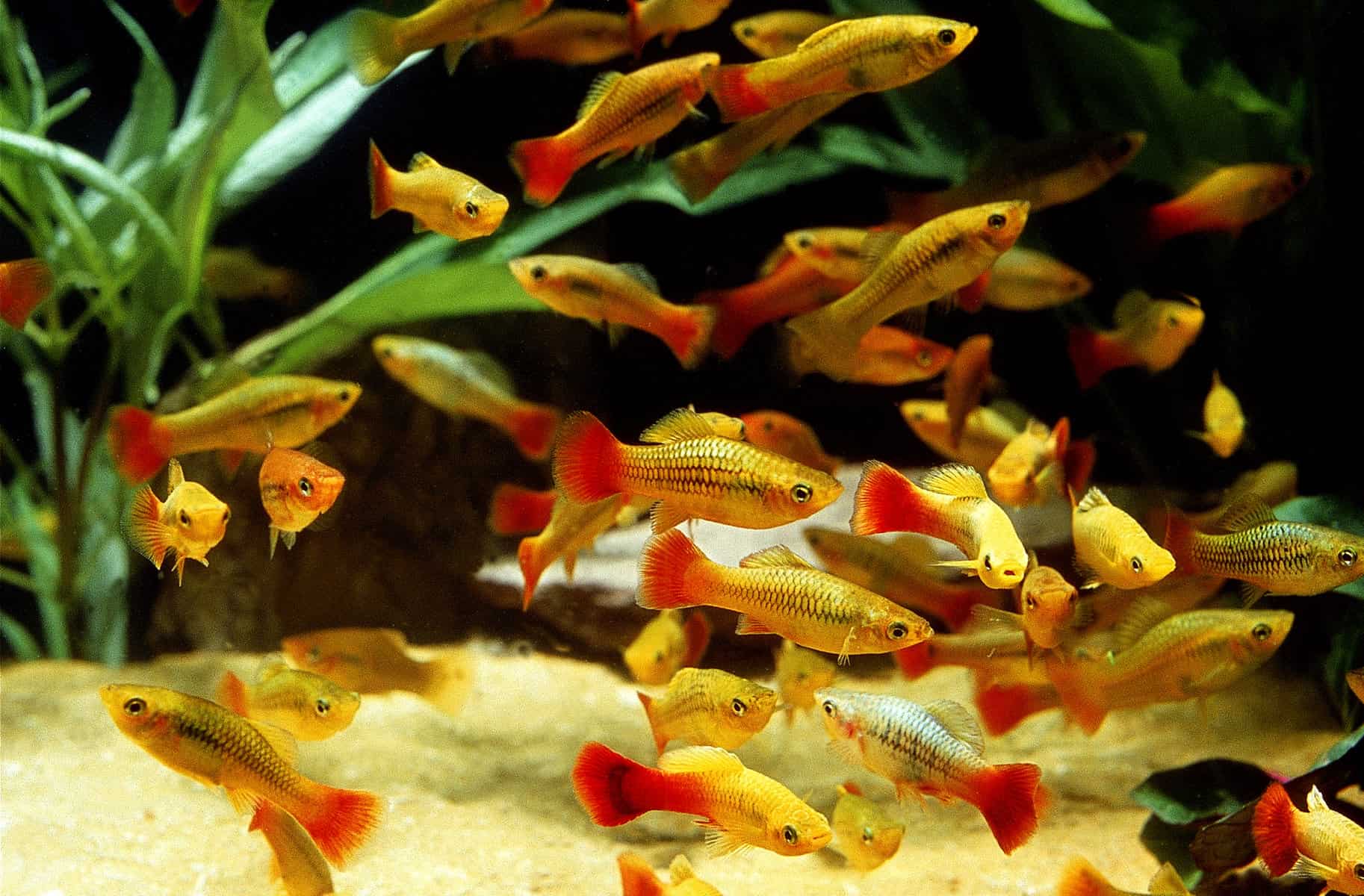
- Scientific Name: Xiphophorus variatus
- Water Temperature: 68-79°F
- Maximum Size: 2-3 inches
- Average Lifespan: 3-4 years
Although platies are not normally listed as an ‘algae-eater’, they will actually consume many types of algae, including hair algae, staghorn algae, and brown algae, especially when they’re not indulged too much with other foods.
Platies also make colorful, interesting tank mates for goldfish, and while they’re fairly small fish, their quick, agile nature means they should be able to get out of harm’s way if your goldfish is ever in a bad mood (or hungry!).
Whereas other livebearers prefer warmer water than the typical goldfish tank, variable platies can tolerate water temperatures down to 68°F, making them perfectly compatible in this way.
Doctor Fish or Garra Fish
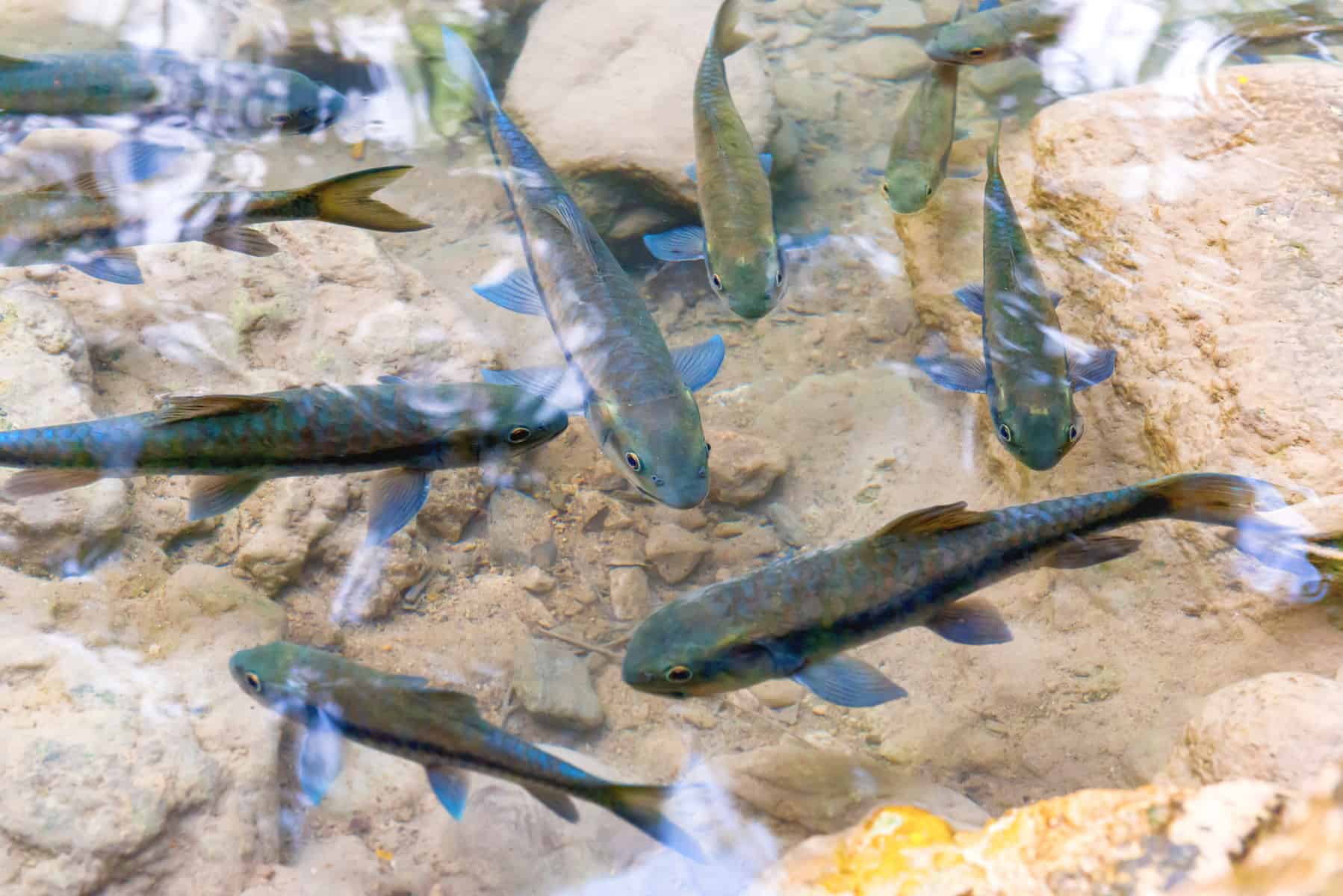
- Scientific Name: Garra rufa
- Water Temperature: 60-75°F
- Maximum Size: 5.5 inches
- Average Lifespan: 3-7 years
The final fish on our list that can make a great algae-eating companion for goldfish is also one that some of you will never have heard of.
The ‘doctor fish’ or ‘red garra’ is not a tropical fish, but a coldwater species that comes from the middle east. Although it grows to a medium-large size it is generally peaceful towards other fish species.
Doctor fish are so-called because of their reputation to heal certain skin conditions, such as psoriasis in humans. Researchers in Romania also found evidence that this species could perform a similar treatment for goldfish with fin rot!
Like some of the other algae eaters, the garra fish has a sucker mouth that it can hang onto the aquarium glass with. But, unlike other species, it will sometimes use this ability to climb all the way out of the tank!
Perhaps this behavior is a symptom of discontent with a low-oxygen environment. Garra fish are from fast-flowing streams, so need a strong current and plenty of oxygen in the aquarium to thrive.
Algae Eaters That Are Not Recommended for Goldfish
Here are a few algae-eating fish that are sometimes suggested for goldfish tanks, but didn’t make our list.
Chinese Algae Eaters
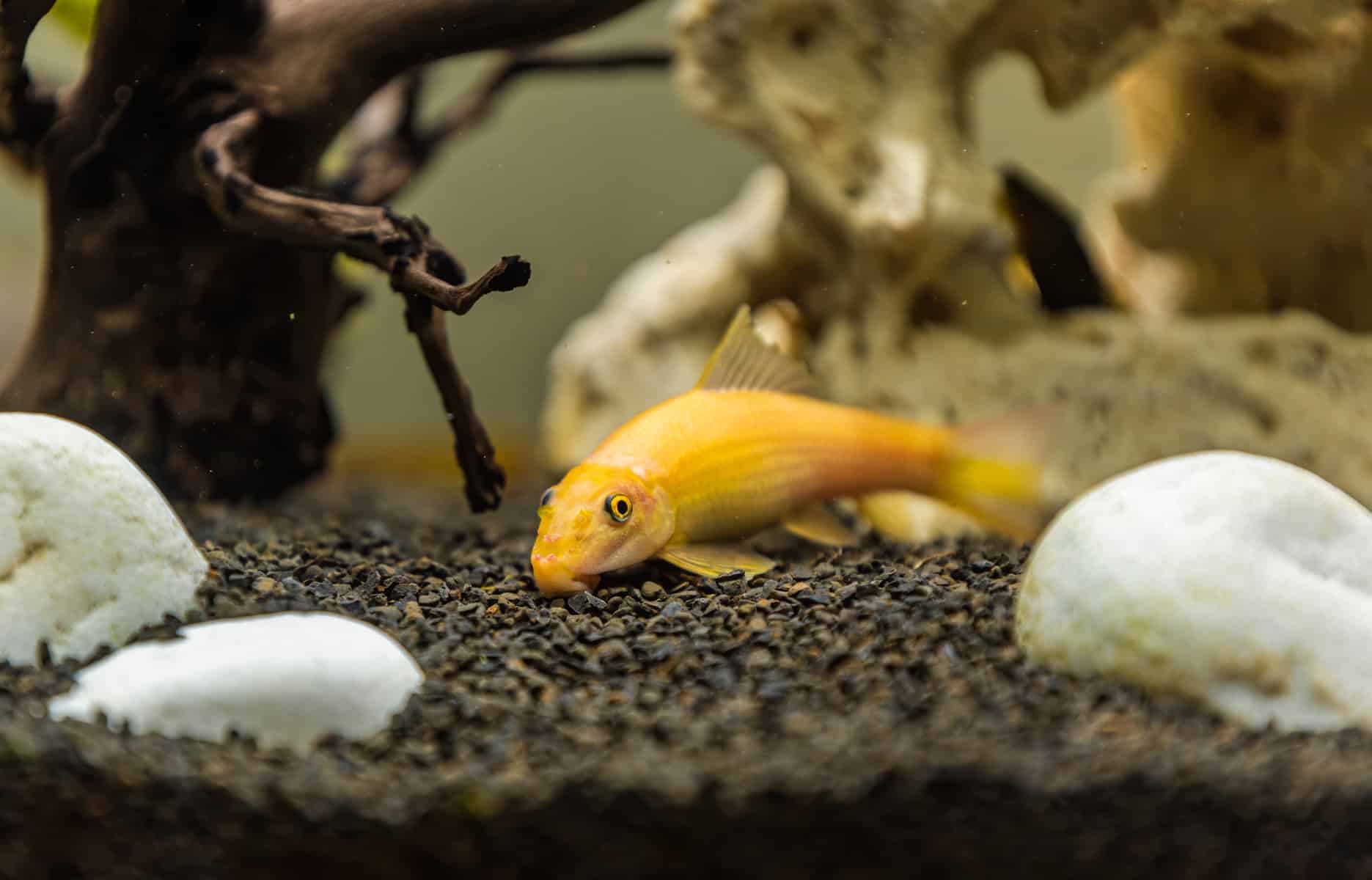
Although Chinese Algae Eaters are indeed excellent at keeping an aquarium free from excessive algae, they also have a dark secret. When they get big, they will often eat smaller fish, and some individuals even like to latch onto larger fish and suck off their slime coats!
This means that even large goldfish are not safe from the ravages of this notorious fish. If their slime coat is removed, goldfish will be more prone to all kinds of skin infections.
The day shall come when these fish are no longer marketed to under-educated fish keepers and they can stay in the wild where they belong.
Hillstream Loaches
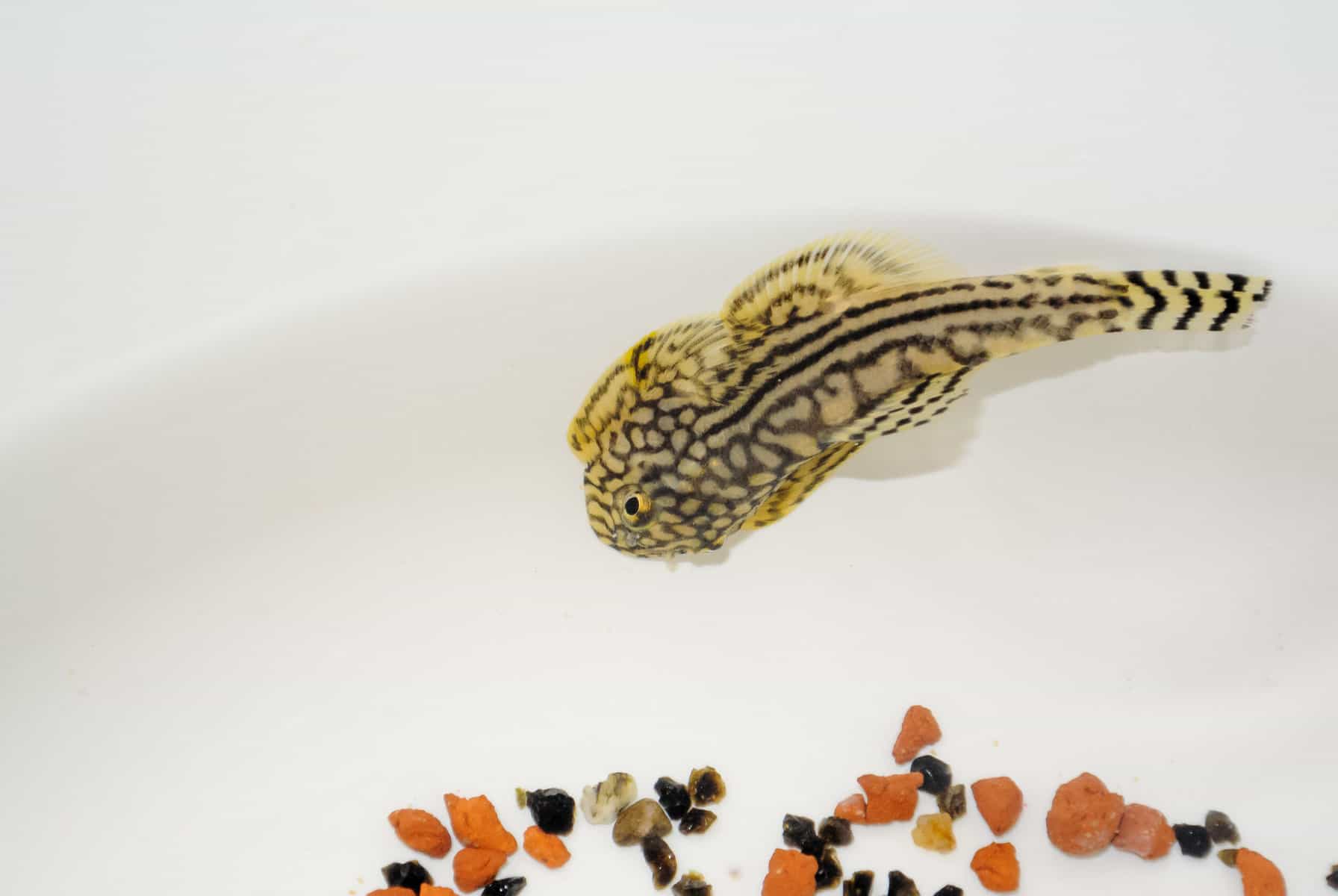
Hillstream loaches are incredibly beautiful fish that do a marvelous job at cleaning fish tanks of algae. Sadly, something that is rarely told about these fish is that they need a specialist tank set up to survive and thrive.
Because they come from fast-flowing hill streams with cool water and very high oxygen content, hillstream loaches need aquariums that closely resemble their natural habitat to remain healthy.
All too often they’re kept in tanks with insufficient oxygen or water current and die prematurely.
Definitely not for goldfish tanks!
Otocinclus Catfish
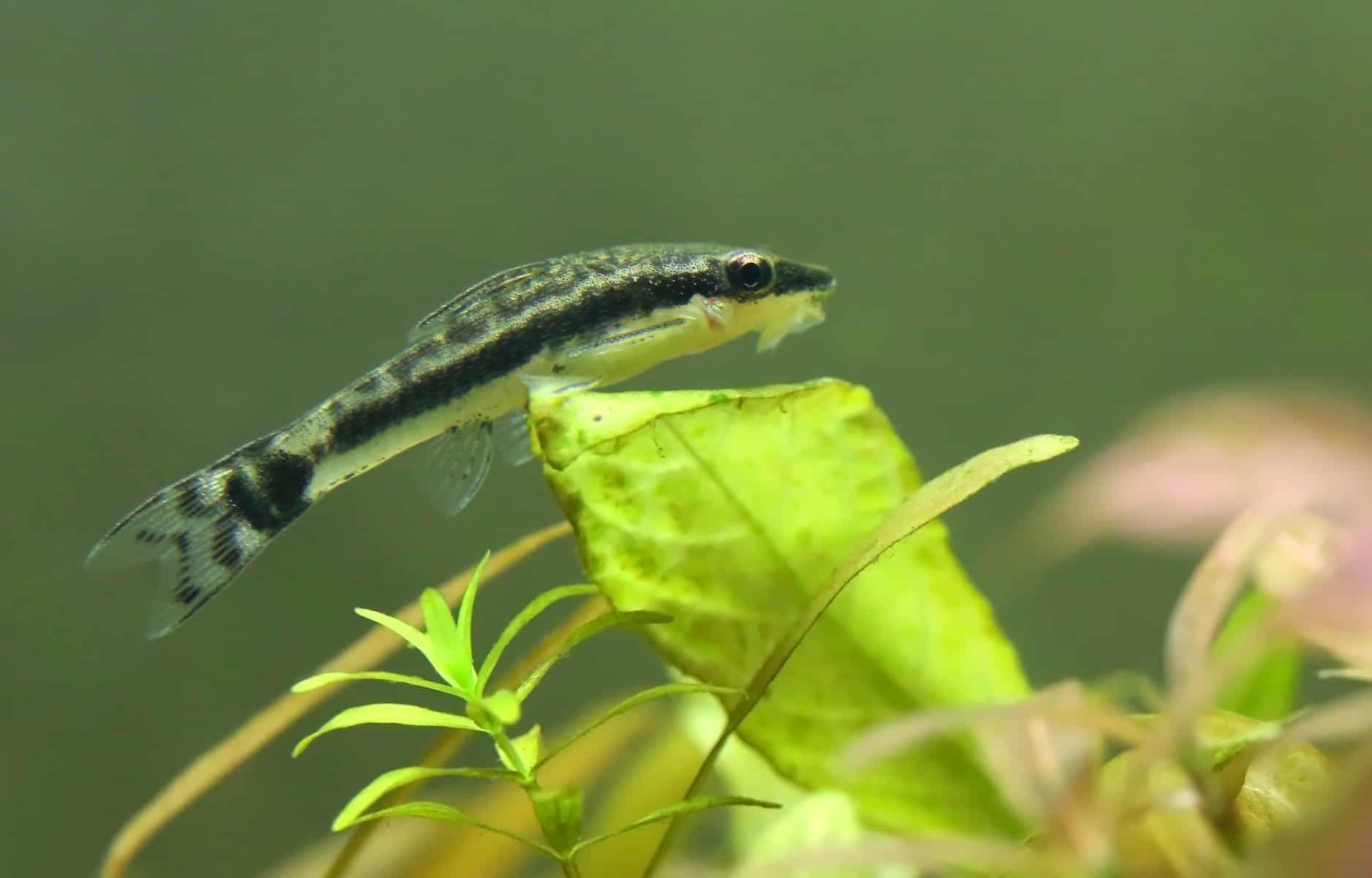
Although ‘Otocinclus’, or otto catfish, can tolerate the same water temperatures as goldfish and are good at eating algae, we wouldn’t recommend that they share the same tank.
Otto catfish are simply too small to make good companions for goldfish in the long run, and there are horror stories on aquarium forums detailing how goldfish can swallow otto catfish while they browse algae – yuck!
Other Ways To Reduce Algae in Your Goldfish Tank
While employing an algae eater to help you reduce the level of algae in your goldfish tank can be helpful, it might not help you solve the root cause of the algae problem.
Algae blooms are so common in goldfish tanks because goldfish are notoriously messy.
Their voracious appetites and high bioload mean the tank is constantly filled with fish waste. Fish waste creates high levels of nitrates and phosphates in the water which then feeds the algae.
In other words, to reduce the amount of algae growing in your tank, you need to reduce the levels of nitrates and phosphates in the water. Here’s how:
Less Feeding
Goldfish are notoriously greedy fish, but you don’t have to pander to their excessive appetites!
Your goldfish will be much more healthy and your water quality could improve dramatically if you feed them only twice a day and no more than they can consume within 2 minutes.
Frequent Water Changes
Partial water changes are a routine part of aquarium maintenance and are especially important for goldfish.
If you have high levels of algae in your tank, consider increasing the size and frequency of your water changes. Some authorities suggest changing 30% of your goldfish tank water every week.
Gravel Vacuuming
Even if your algae appears mostly on your rocks or glass, it is the detritus in the gravel that’s causing the problem.
Keep your substrate clean by hoovering your gravel every time you change the tank’s water.
Strong Filtration
Since goldfish are such messy fish, they need extra strong filtration.
A powerful hang-on-back filter with carbon filtration or a canister filter are the best choices, with more powerful flow being necessary as the goldfish grows bigger.
To check out our guide to the best filters for larger tanks, click here.


























